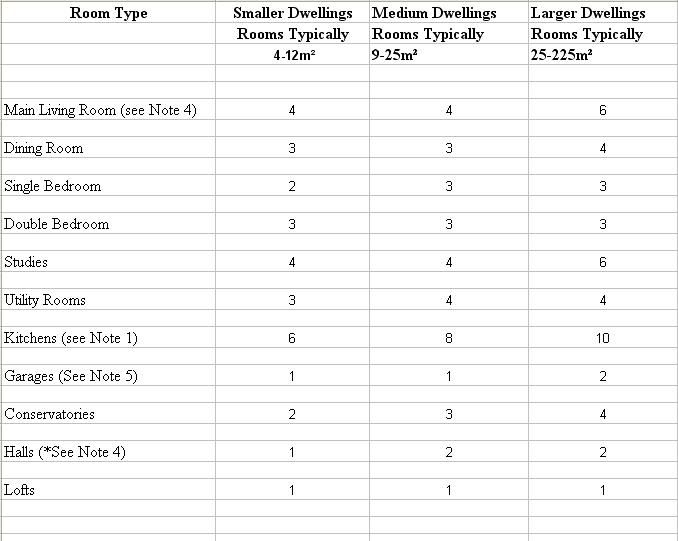I was recently sent a draft document from the ECA. The document takes a look at the issues surrounding the adequate provision of electrical socket outlets in the home for safety.
What does anyone think? (sorry its quite a long post)

Notes:
1. Kitchen – if a socket-outlet is provided in the cooker control unit, this should not be included in the 6 recommended in the Table above.
The socket-outlets are primarily for portable appliance connections. Fixed
appliances should have appropriate additional outlets. Some appliances such as a central heating boiler are likely to require an additional socket-outlet, which should be borne in mind in the initial installation design. It has been shown as a separate item in the schedule, as its location can vary according to the dwelling.
Fixed equipment such as Immersion Heaters should not be connected via socket outlets: a separate circuit should be provided,
incorporating a double pole switch of appropriate rating.
Rule of thumb as follows: - Allow 0.8 to 1 double sockets per linear metre above worktop (minimum)
2. Garage – The number of socket-outlets specified allows for the use of a battery charger, tools, portable light and garden appliances. It is important that this circuit be protected by a high sensitivity residual current device (earth leakage circuit breaker).
3. Single Bedroom – it is envisaged that this room will be used in different ways in different households. It may be used simply as a child’s bedroom requiring socket-outlets for table lamps, an electric blanket and a fire only; or it may serve as a teenager’s bedroom and living room combined, where friends are entertained. In this case, socket outlets may be needed for hifi/home cinema system, hairdryer, television and radio, in addition to lamps, a blanket and a fire.
The room may also be used as a student’s bed sitting room, in which case socketoutlets may be needed for a grill or toaster, iron, hi-fi equipment, home computer and a kettle, in addition to items already mentioned. If the room is used for the latter purpose, the minimum number of twin outlets should be increased to 4, as shown in the Table above.
4. TV entertainment areas – it is recommended to install two double socket outlets in these areas as a minimum; this is in addition to other socket outlets in the room.
5. For high specification properties – a good specification for general rooms is to install a double socket outlet in each corner of the room.
6. Halls - single socket outlets may be fitted as an alternative in halls.
What does anyone think? (sorry its quite a long post)

Notes:
1. Kitchen – if a socket-outlet is provided in the cooker control unit, this should not be included in the 6 recommended in the Table above.
The socket-outlets are primarily for portable appliance connections. Fixed
appliances should have appropriate additional outlets. Some appliances such as a central heating boiler are likely to require an additional socket-outlet, which should be borne in mind in the initial installation design. It has been shown as a separate item in the schedule, as its location can vary according to the dwelling.
Fixed equipment such as Immersion Heaters should not be connected via socket outlets: a separate circuit should be provided,
incorporating a double pole switch of appropriate rating.
Rule of thumb as follows: - Allow 0.8 to 1 double sockets per linear metre above worktop (minimum)
2. Garage – The number of socket-outlets specified allows for the use of a battery charger, tools, portable light and garden appliances. It is important that this circuit be protected by a high sensitivity residual current device (earth leakage circuit breaker).
3. Single Bedroom – it is envisaged that this room will be used in different ways in different households. It may be used simply as a child’s bedroom requiring socket-outlets for table lamps, an electric blanket and a fire only; or it may serve as a teenager’s bedroom and living room combined, where friends are entertained. In this case, socket outlets may be needed for hifi/home cinema system, hairdryer, television and radio, in addition to lamps, a blanket and a fire.
The room may also be used as a student’s bed sitting room, in which case socketoutlets may be needed for a grill or toaster, iron, hi-fi equipment, home computer and a kettle, in addition to items already mentioned. If the room is used for the latter purpose, the minimum number of twin outlets should be increased to 4, as shown in the Table above.
4. TV entertainment areas – it is recommended to install two double socket outlets in these areas as a minimum; this is in addition to other socket outlets in the room.
5. For high specification properties – a good specification for general rooms is to install a double socket outlet in each corner of the room.
6. Halls - single socket outlets may be fitted as an alternative in halls.

